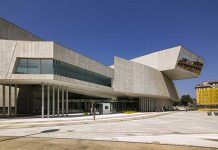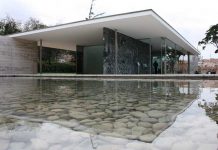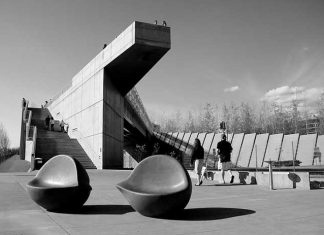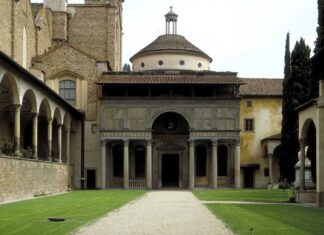Sir Norman Foster, one of the most famous architects of High-tech architecture, was born in 1935 in Manchester, England. After graduating from Manchester University Department of Architecture, which is shown among the best architecture schools in the world, he completed his master’s degree at Yale University. He has became one of the leading architects of the 21st century with the iconic building designs he produced in the era of high technology. In this article, we will examine the 10 most prominent structures among Norman Foster buildings.
List of Norman Foster Buildings
1. Gherkin
The Gherkin building, which he designed in 2003, is one of the most important parts of the London skyline with its simple mass that looks like bullets. Moreover, the Gherkin is among the Norman Foster works that have made his mark and come to the for in popular culture.
The mass, tapering upwards, has been designed in such a way that the wind will touch the building the least, with its singular-infinite facade that does not contain a sharp surface. Thus, Foster has succeeded in reducing the wind load, one of the biggest structural problems of skyscrapers, to the lightest level possible.
Gherkin is a special 41-floor building with open-plan spaces on each floor, providing energy efficiency and active wind circulation thanks to the panels on its facade.

When designing the Gherkin building, Foster was inspired by the skeleton of a sponge called the Venus flower basket. You should definitely read our Biomimicry in Architecture article to learn about biomimicry and how the Gherkin building was inspired by the nature.
2. Great Court of British Museum
The Great Court of the British Museum in England, which was originally a garden, is covered with an amorphous cover gracefully designed by the architect Norman Foster. This British Museum, which welcomes more than 6 million visitors a year, has witnessed a magnificent space transformation thanks to the modern roof covering its courtyard.
This modern addition designed by Foster for the British Museum is one of the most successful examples of modern architectural designs added to historical buildings. 3212 pieces of triangular glass panels, each different from the other, were used in the roofage, the construction of which was started in 1999.
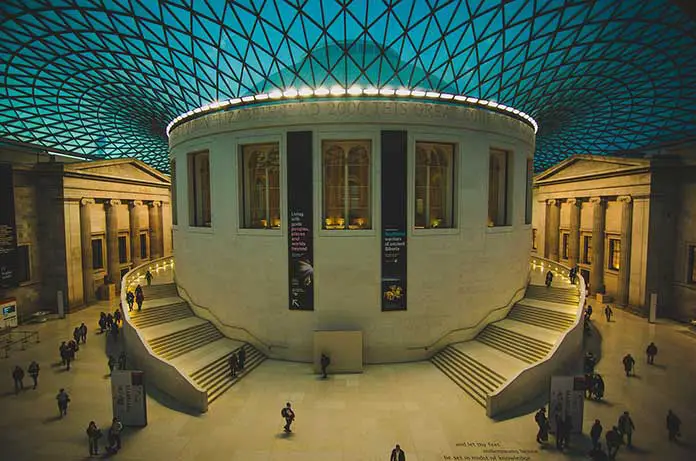
Founded in 1753, the British Museum is the world’s first public and national museum. This design of Sir Norman Foster for such an important historical building has made the museum one of the most aesthetic structures of the age.
3. HSBC Headquarters
Constructed between 1979-1986, the Honk Kong and Shanghai Banking Corporation (HSBC) building is the first project of Foster & Partners to make a global impact. The building is one of the most successful examples of high-tech architecture.

Steel trusses and elevators are located outside the building. In this way, free space was created in the interior emptied from the elevators, and it became easier to organize the volumes and design the open spaces. This 50-storey skyscraper is like a glamorous summary of Norman Foster buildings, with the use of steel and glass as if they were parts of a machine.
4. Willis Faber & Dumas Headquarters
The office building designed by Foster & Partners in Ipswich, England in 1971 seems to have been designed as a harsh reaction to traditional office design. It is possible to make vertical circulation between storeys with escalators, which is a great innovation for the period when the building was built.
Architects anticipated that the flow of information and technologies would improve, and thought that the wiring in the offices would increase in the future. In this direction, they increased the floor heights and made empty spaces for cables and panels.
Foster is extremely interested in green architecture as well as high-tech architecture. The Willis building, which has a grass-covered green roof design, is a building that stands out with its low energy consumption. With its architectural value and pioneering design, the building is among the youngest structures under 1st degree protection.
5. Reichstag Restoration
Reichstag, the German Parliament building, is an extremely important and symbolic building for the Germans. It had hosted the assemblies of the German Empire and the Weimar Republic. This neo-renaissance style building was built in Berlin between 1884 and 1894.
It could not be used for a long time due to the heavy damage it hit in the Reichstag fire in 1933 and during the 2nd World War. Although it was restored afterwards, it was used for the exhibition purposes.
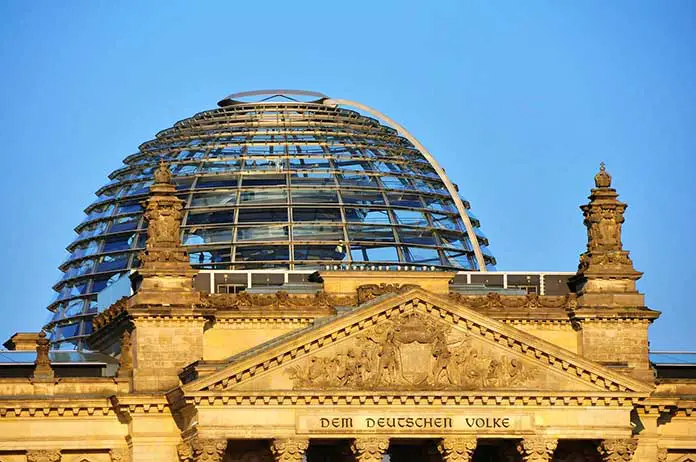
With the re-union of Germany and having a federal assembly in 1991, Norman Foster began to restore the structure as a result of a competition. With the completion of the restoration, the assembly was put into service in 1999. During this restoration, the damaged areas were repaired. But the most striking change was the hemispherical glass dome positioned above the main meeting room.
Open to the public, the glass dome transmits sunlight directly to the main hall of the parliament. This design is one of the most important additions in the history of architecture, just like the roofing of the Great Court of the British Museum.
6. Millenium Bridge
Opened by Queen Elizabeth II in 2000, the Millennium Bridge is London’s first pedestrian bridge. Far from the usual bridge designs, Millennium connects the two sides of the river with the minimum effort and touch. This suspension bridge, whose main material is steel, passes a total span of 320 meters.
The bridge has 2 Y-shaped carrier legs in the middle of the river and 4 steel cables on each side connected to these legs. These cables carry 4 meters wide floor slabs.
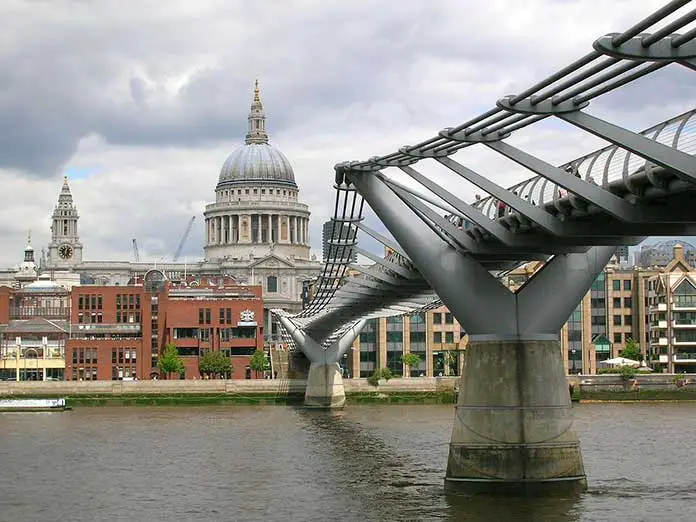
Although nevertheless bridge designs are closely related to engineering science, with the contribution of architects, they can turn into works of art not only in terms of function but also in terms of aesthetics. The Millennium Bridge is one of these art works.
7. Hearst Tower
Completed in 2006, the Hearst Tower is New York’s first Leed-certified high-rise office building. The main structure of the building structure consists of triangular steel frames surrounding the perimeter. Thanks to this special structural design called Diagrid, 21% less steel is used compared to similar sized structures.
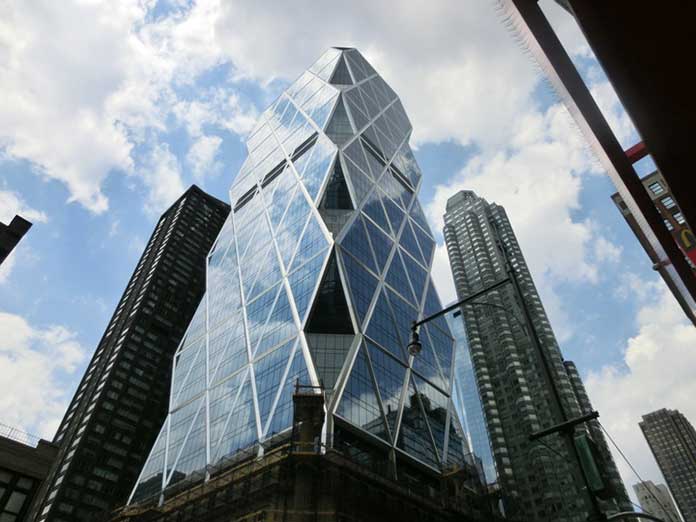
90% of the steel material used in the building is recycled steel. This rate corresponds to approximately 10,480 tons of steel. One of the details that makes the design of the building interesting is that it is articulated on the 6-floors Hearst Magazine Building. This modern building of Norman Foster, using steel and glass, has 40 (+6) floors and 80.000 square meters of office space.
8. London City Hall
London City Hall, or GLA, is located near the River of Thames. The building, which was put into service in 2002, stands out with its unique mass, like many of Norman Foster structures. Extremely effective solutions have been produced in terms of green building features. The sloping form of the building provides shade to the lower floors, so reducing the amount of sunlight entering.
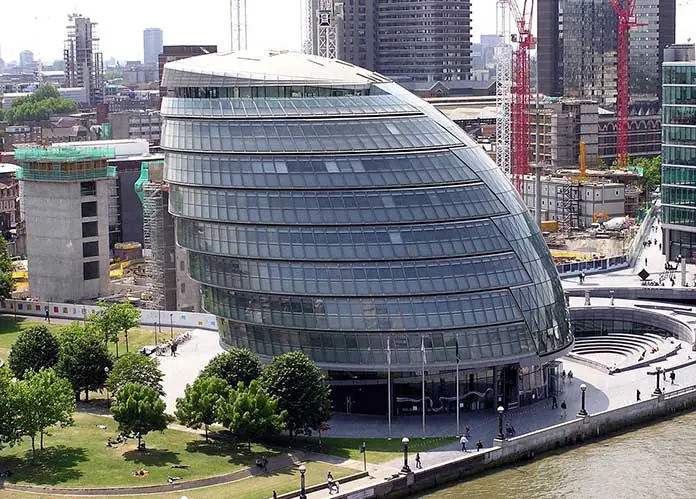
Additionally, thanks to its curvilinear form, just like the Gherkin building, less contact of the wind with the building and reduction of heat loss through the exterior facades are considered. Apart from these, important decisions have been taken in terms of energy efficiency of the building, such as PV panels, triple glazed facade system and the use of heat pump. Thanks to these sustainable architecture strategies that Foster applied, the cooling costs of the GLA building were reduced to almost zero.

The sculptural spiral staircase, designed in harmony with the dynamic form of the building, is one of the most eye-catching designs inside. Thanks to this staircase, a panoramic viewpoint between floors is offered in the interior.
9. Apple Park
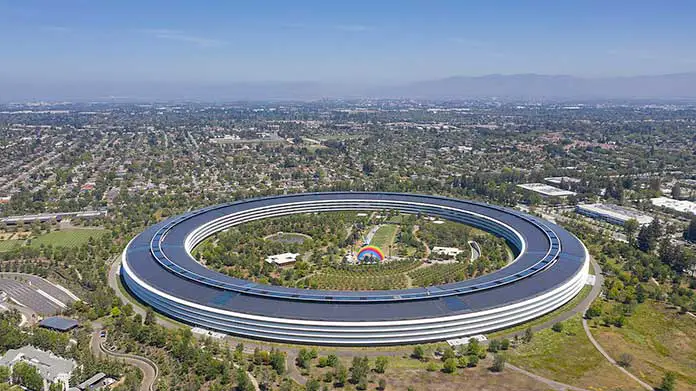
Opened in 2017, Apple Park is one of the newest buildings by Norman Foster. Resembling a giant ring, this structure is the headquarters of Apple, one of the world’s largest technology companies. Rather than an office structure, Apple Park is more like an escape place from a city to nature.
Located in California, this headquarters provides a working environment for more than 12 thousand personnels at the same time. Foster preferred horizontal architecture instead of a vertical skyscraper so that employees can live a working life close to the ground, intertwined with green.
10. Millau Viaduct

Millau, the world’s largest and longest road bridge. It’s one of the most aesthetic and elegant examples of bridge design. Millau, in the category of cable-supported suspension bridges, is also the world’s highest vehicle bridge with 343 meters.
The main construction material of the bridge, which is 32 meters wide and approximately 2500 meters long, is steel. Located in a valley in the south of France, the viaduct takes its name from the nearby town of Millau.
In this article, we briefly explained the 10 projects that we selected among the Norman Foster buildings that we found most successful. These buildings, each more valuable than the other, have an aesthetic understanding that has permanent effects on the architecture of the 21st century and leads the architectural design. You can share your favorite works of Norman Foster with us in the comments section.






